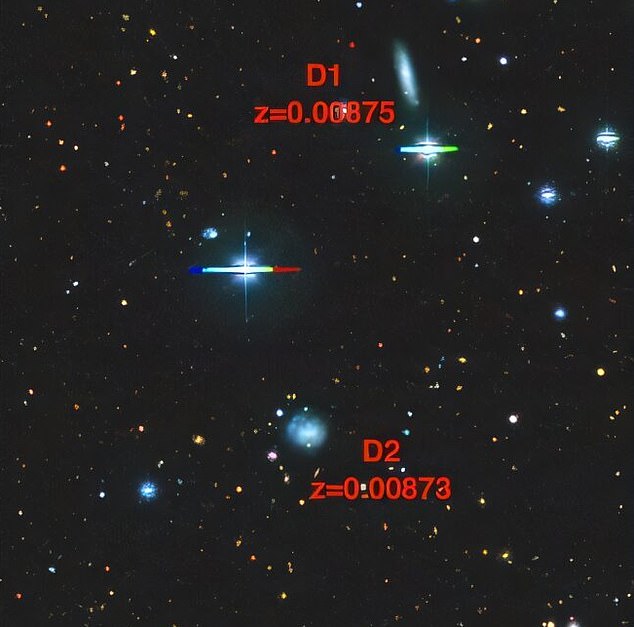Astronomers have discovered an extremely rare group of five ‘dwarf’ galaxies that are ‘interacting with each other’ about 117 million light years away from Earth
Dwarf galaxies contain a few billion stars, whereas standard galaxies have hundreds of billions, giving them low mass and luminosity.
The newly found galaxies are blue, gas-rich and actively forming new stars.
They were designated from D1 to D5, and D3 and D4 are showing signs of mutual tidal interactions, which means their respective gravitational forces are pulling on each other and distorting the galaxies’ shapes.
D3 and D4 have developed ‘tidal tails,’ or thin, elongated regions of stars and interstellar gas that stretch out and away from the point where the galaxies collide.
It is highly uncommon for dwarf galaxies to appear in groups as studies suggest less than five percent of dwarf galaxies are neighbors with another.
Thus, there is less an a 0.004 percent chance that a dwarf galaxy would be so close to four others.
Despite those incredibly low odds, ‘We have identified a distinct group of dwarf galaxies, with all five members aligned along a straight line in the celestial plane and three sharing a common rotational direction,’ the researchers wrote in their report.
The discovery of this exceedingly unique group is forcing scientists to question the prevailing model of our universe, but should also help scientists better understand how dwarf galaxies form and evolve.

The group of dwarf galaxies, designated D1 through D5, is exceedingly rare
A team of researchers led by the Yonsei University in Seoul, South Korea, discovered the dwarf galaxy group by analyzing data from various astronomical surveys that continually scan space looking for new discoveries.
These surveys use telescopes to observe millions of celestial objects in deep space, creating enormous, highly detailed maps of the universe.
The researchers’ analysis revealed the presence of the group of dwarf galaxies, isolated together in deep space.
They estimated the total dynamical mass – or the mass of an object inferred from its movement relative to other objects – of the group to be roughly 60.2 billion times the mass of our sun, the study found.
Their individual masses vary widely. The largest group member, galaxy D2, has a stellar mass of approximately 275 million solar masses.
The least massive, D4, has a stellar mass of only 14.7 million solar masses.
For comparison, our galaxy – the Milky Way – has a stellar mass of about 1.5 trillion solar masses, according to NASA.
The researchers published their findings in The Astrophysical Journal Letters on November 19.

They were designated from D1 to D5, and two of them – D3 and D4 – are showing signs of mutual tidal interactions , which means their respective gravitational forces are pulling on each other and distorting the galaxies’ shapes

Dwarf galaxies only contain a few billion stars , whereas standard galaxies have hundreds of billions. This is irregular dwarf galaxy NGC 6822 – which is not part of the newly found group
To find five dwarf galaxies grouped together in a near-straight line, with most of them rotating in the same direction, is so unusual that it challenges predictions made by the prevailing model of how the universe formed.
That model, called Lambda cold dark matter (LCDM), suggests that dark matter causes disordered groupings of galaxies.
By that logic, galaxies are not expected to have a preferred alignment. The five dwarf galaxies, however, are aligned in a configuration that is ‘not frequently seen in CDM simulations,’ study lead author Sanjaya Paudel of Yonsei University in South Korea told Space.com.
What’s more, the fact that three of the five galaxies share the same direction of rotation – as shown by DESI observations – suggests that they formed from the same cloud of gas. This further contradicts the LCDM model.
‘Why do they have the same rotation?’ said Paudel. ‘They must have a connection with each other – that would be a very strong question that cannot be explained by the ΛCDM model.’
As of now, this discovery yields more questions than answers. But future studies could soon confirm whether the galaxies’ unlikely configuration is a chance projection or a real physical arrangement, the researchers stated in their report.
Additionally, studying these five dwarf galaxies could help scientists better understand how such objects form and evolve.
Astronomers believe dwarf galaxies were created by gravitational forces in the early stages of the creation of larger galaxies, or as a result of collisions between galaxies that eject streams of material out into space.
Dwarf galaxies are thought to be important for important in scientists’ understanding of the overall evolution of galaxies, according to the European Space Agency.
Those that lack a defined shape – known as ‘irregular’ dwarf galaxies – are considered similar to the earliest galaxies that populated the Universe. Thus, studying them offers a glimpse into ancient cosmological history.
More than 20 known dwarf galaxies orbit the Milky Way. But they are locationally and gravitationally separate from each other, not grouped together.
This article was originally published by a www.dailymail.co.uk . Read the Original article here. .


